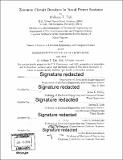| dc.contributor.advisor | James L. Kirtley. | en_US |
| dc.contributor.author | Taft, William T.(William Theodore) | en_US |
| dc.contributor.other | Massachusetts Institute of Technology. Department of Mechanical Engineering. | en_US |
| dc.contributor.other | Massachusetts Institute of Technology. Department of Electrical Engineering and Computer Science. | en_US |
| dc.date.accessioned | 2019-10-16T21:32:11Z | |
| dc.date.available | 2019-10-16T21:32:11Z | |
| dc.date.copyright | 2019 | en_US |
| dc.date.issued | 2019 | en_US |
| dc.date.issued | 2019 | en_US |
| dc.identifier.uri | https://hdl.handle.net/1721.1/122611 | |
| dc.description | Thesis: Nav. E., Massachusetts Institute of Technology, Department of Mechanical Engineering, 2019 | en_US |
| dc.description | Thesis: S.M., Massachusetts Institute of Technology, Department of Electrical Engineering and Computer Science, 2019 | en_US |
| dc.description | Cataloged from PDF version of thesis. | en_US |
| dc.description | Includes bibliographical references (pages 97-100). | en_US |
| dc.description.abstract | New power system components and control systems are required to facilitate the U.S. Navy's move to medium voltage direct current power (MVDC) systems on future vessels. Integrating the z-source circuit breaker into a "typical" naval MVDC power system requires understanding system dynamics that may cause the circuit breaker to inadvertently energize a circuit through regenerative turn-on of the thyristor. An electrically-scaled model and a simulation model are used to characterize voltage transients that could lead to this false triggering. The results of this experiment show that these transients are within the specifications of commercially available components. Limitations in the circuit breaker's protective capabilities during turn-on transients are identified and discussed. Potential topology modifications, control schemes, and power system arrangements that provide protection across the operating range are proposed for further investigation. | en_US |
| dc.description.statementofresponsibility | by William T. Taft. | en_US |
| dc.format.extent | 100 pages | en_US |
| dc.language.iso | eng | en_US |
| dc.publisher | Massachusetts Institute of Technology | en_US |
| dc.rights | MIT theses are protected by copyright. They may be viewed, downloaded, or printed from this source but further reproduction or distribution in any format is prohibited without written permission. | en_US |
| dc.rights.uri | http://dspace.mit.edu/handle/1721.1/7582 | en_US |
| dc.subject | Mechanical Engineering. | en_US |
| dc.subject | Electrical Engineering and Computer Science. | en_US |
| dc.title | Z-source circuit breakers in naval power systems | en_US |
| dc.type | Thesis | en_US |
| dc.description.degree | Nav. E. | en_US |
| dc.description.degree | S.M. | en_US |
| dc.contributor.department | Massachusetts Institute of Technology. Department of Mechanical Engineering | en_US |
| dc.contributor.department | Massachusetts Institute of Technology. Department of Electrical Engineering and Computer Science | en_US |
| dc.identifier.oclc | 1117714359 | en_US |
| dc.description.collection | Nav.E. Massachusetts Institute of Technology, Department of Mechanical Engineering | en_US |
| dc.description.collection | S.M. Massachusetts Institute of Technology, Department of Electrical Engineering and Computer Science | en_US |
| dspace.imported | 2019-10-16T21:32:09Z | en_US |
| mit.thesis.degree | Master | en_US |
| mit.thesis.department | MechE | en_US |
| mit.thesis.department | EECS | en_US |
